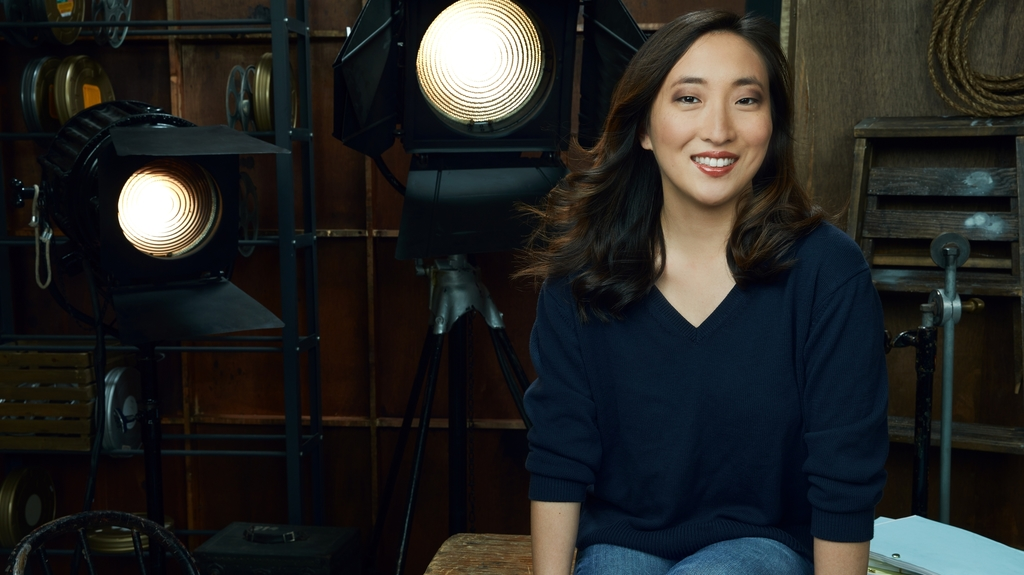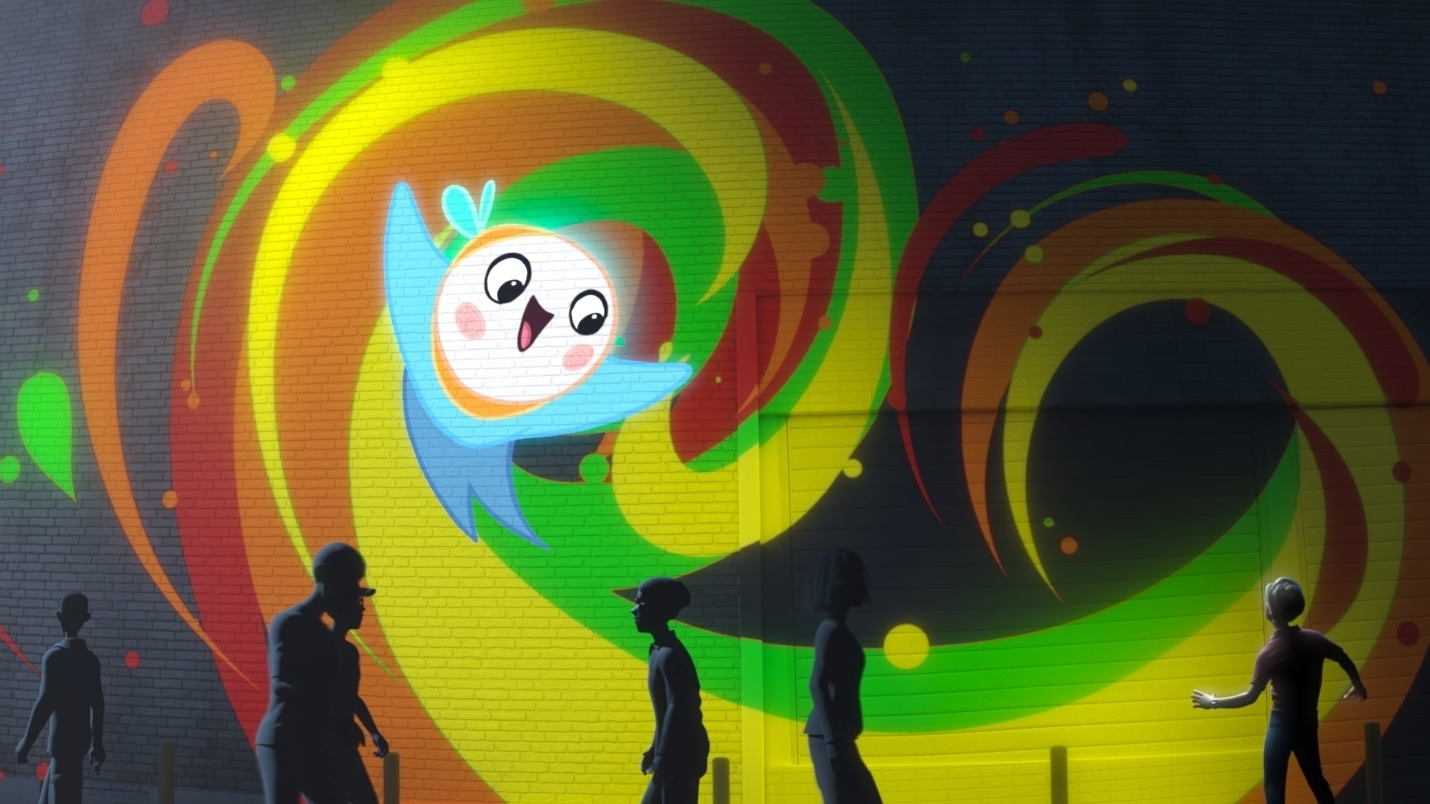Kendra Vander Vliet is a Layout Artist at Walt Disney Animation Studios who has worked on films and shorts including Frozen, Feast, Big Hero 6, Zootopia, Moana, Olaf’s Frozen Adventure, Ralph Breaks the Internet, Frozen 2, and the upcoming Raya and the Last Dragon. Her directorial debut recently launched on Disney+ with Downtown, part of the Short Circuit experimental film program. I recently interviewed Kendra about her short during a visit to Walt Disney Animation Studios in Burbank.
Alex: In your intro, you mentioned being influenced by Japanese anime. The bird character has a particularly kawaii esthetic. Can you talk about the decision behind that character?
Kendra Vander Vliet: It’s funny that you say a bird, it was actually a manta ray. It was kind of funny and cute with its face on there when his wings are outstretched. My character designer used that, he came up with the idea of like a fidget spinner and then you mix in, that’s why he spins around. We tried to keep that very playful and it seemed like an interesting concept that we rolled with.
Alex: The energy of it is really exciting from start to finish. We’re there any specific works of anime that were an inspiration for you?
Kendra: I was referencing a lot of One Punch Man, Kill la Kill, Mob Psycho, Evangeleon, and trying to study what do they do in those action sequences that make them feel that way. And one of the things I was seeing is that even though they’re on their lenses in 2D animation, it looks like a wide lens. Everything like when a character takes a giant step, that step feels like it’s coming towards you and a wide lens will help you get that. And they used these tricks all the time in how they Dutch the camera and everything. I was playing around with that and using characters that go by the screen really fast on a really short lens. We used a 6mm lens at one point, so it creates a really dynamic effect and you mostly really feel it. Instead of using something that would frame a character beautifully, we wanted something that had a lot of energy. Using those same kinds of references, how Japanese animation artists were using, and trying to find ways to bring those techniques into a 3D short. Because surprisingly, if you really step through Japanese animation, they actually don’t move a lot. There’s a lot of movement in the action but if you try to convert it just one on one, in some of the tests we did it actually doesn’t feel very energetic. So it’s a complete interpretation of how they do it and trying to make it feel that way.
Alex: The art of downtown LA inspired this idea. Are there any specific pieces of street art that influenced the direction of the short?
Kendra: I really enjoyed very specifically for Downtown, the art had a pop art kind of feel. Graffiti art can be pretty much anything, but specific to downtown it’s almost like pop art. So I was trying to bring that esthetic to everything and one of my favorite artists, Yoyoi Kusuma, who does a lot of pop art with big blotchy colors and lots of spots. So there’s something really appealing with that, even if you looked at it from far away, that you get an instant read. We were trying to bring that quality along with regular qualities of downtown art. With everything going by so fast, we didn’t want tiny minute details. We really wanted a quick read so you get the emotion of the color instead of the details.
Alex: The colors are so bright and vivid, almost like a kaleidoscope. Did you seek out any specific colors?
Kendra: We referenced the color wheel because you know how movies have their color styles, we took the color wheel and just spun the whole thing. When we go through a bunch of colors, we’re intentionally just spinning the colors of the color wheel.
Alex: Do you know off the top of your head how many colors are in that trail of art that comes off the character?
Kendra: I don’t, my Production Designer did a hundred graffiti designs for the short and it’s kind of surprising for something so short to have that much graffiti art. But then once you try to get all those colors and shape reads, it all adds up and really adds to the dynamicness of everything.
Alex: None of the characters have faces or skin tones and as an audience member, you can project your world into that space. Is that what you were going for?
Kendra: Totally. Since I wanted the short to really be about the emotion, how do you feel energy, how do you feel joy specifically and what are the shapes and colors that give you this feeling. I felt showing a character’s face was really distracting. You almost start to think about who is that person, who’s that guy, who’s that girl. I just want people to be able to project themself and relate. Being in a big city, you almost feel kind of anonymous in a crowd. So hiding the face relates how I feel in a big city and when you see something really colorful or that inspires you for a moment like graffiti art, you can maybe have that same journey the guy goes through. Gives you that little spark of life.
Alex: Animation fans and enthusiasts view it as an art form, but not everyone sees it that way. On Disney+, your short might make some viewers look at the medium differently. Was that a goal of yours or would it be an unintentional side effect?
Kendra: Maybe it’s an unintentional side effect, but it sounds like a really good one.
Alex: The environment here at Disney Animation seems so collaborative and supportive. What is it like to work in this environment and how rare do you think this is?
Kendra: One of the really incredible things about doing this, especially at Disney, people might think oh, maybe someone is telling us how to do our story. It’s truly this opportunity at a big studio that is 100% our idea and we can roll with it however we want. That kind of creative freedom is almost unheard of in a huge studio and so that was a huge honor to be able to do. And then also a huge responsibility, which kind of makes you think about what makes you want to be a director in the first place. Someone shouldn’t get into directing just because they want to, it should be something in their story that inspires them to want to try and take on a role like this. Because it is stressful and I think whenever I hear someone say directing is hard, until you do it you don’t realize how hard it is. It’s quite literally the craziest thing ever. For anyone, if they want to direct or do something like this, find a thing that inspires you to do your story. For me, it was camera cinematography and animation and seeing if I could explore that and knowing that no one would do that unless I stepped into a director chair. So that kind of gave me enough energy to be able to direct. And then also not be as intimidated as I might seem to be in a big studio to create a little short like this. At least then I have a goal, a vision so that when I talk to people who made The Little Mermaid, at least I know what I’m asking for and I can not feel afraid. Feel brave enough to carry on the legacy in this studio that we have.
Alex: Cinematography is a niche interest to begin with and Animation cinematography even more so. How did your interests lead to this point?
Kendra: I’ve always been fascinated with camera work and really interesting, streaming has pushed cinematography even for live action and animation in ways I don’t think people have seen before. You can really experiment now and tell stories in unique ways. I was like I’d love to see that at the studio and even with my own project. Try a different set of lens, a different type of framing to tell in my narrative and I’d love to do more of that in the future. It’s so fun.
Alex: In animation, you’re not working with a traditional camera but a set of computer tools that can inform what we see and how we see it. How do you make those kinds of decisions?
Kendra: They actually build a camera in the computer that’s based off a real life camera. I think the difference is maybe on a live action show, they might have a different set of lenses, different brands to choose from, they might have ways of lighting the light differently. But we have kind of this one camera that we’ve made, so trying to use that in really creative ways to feel and look different is actually very challenging and there’s a lot of tech behind that. Trying to distinguish my short, like my camera lens is the same lens we’ve used for all of our feature films. So finding ways to make it feel different, just like what you see on the screen. So by bringing old technology, distortions, layering, to give it a unique voice for my story is hopefully something we can do more of in the future, too. But it is a lot of tech work.
Alex: What were some of your Disney inspirations that made you want to work at Walt Disney Animation Studios?
Kendra: I’ve always loved Disney. When I came on Frozen, I actually just wanted to focus on rough layout so I left a previous job and came over to Disney. They were like yeah, come be a Rough Layout Artist. That was how I got here. I’ve been always trying to grow and do more with camera work and even character animation and getting better… Watching The Lion King, that’s everyone’s favorite movie but it’s crazy inspiring to have the goal of getting here and never expecting to get here so I was surprised. They were like ‘You’re hired.’ I’m sure everyone feels that way deep down inside.
You can stream Downtown and all of the Short Circuit films on Disney+.


